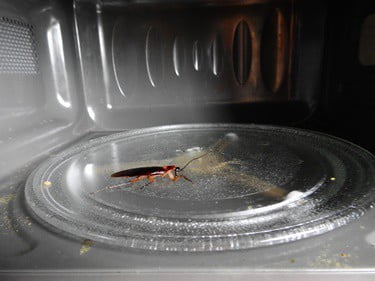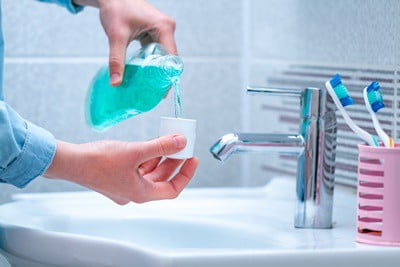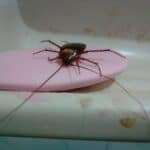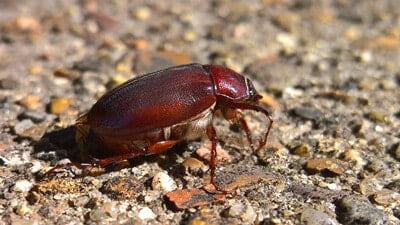You may feel confident that your microwave will kill cockroaches, but the heat and radiation from the appliance barely affect them. Your first thought may be to remove the cockroaches with pesticides, but doing so could ruin your microwave and cause an electrical fire.
To avoid causing damage to your microwave, use dust or bait traps to lure cockroaches from the appliance. Deep clean the microwave to remove grease and food debris with fresh lemon as a natural deterrent.
Raid spray and bug bombs are among the worst extermination methods you could use to get cockroaches out of your microwave. Similarly, avoid using anything water-based, as it’ll damage your microwave and corrode the internal parts. To salvage your microwave, give it a deep clean and sanitize all parts.
Do Cockroaches Live in Microwaves?
Cockroaches are notorious for hiding and resting in all corners of the home. They prefer hiding spots that are secluded, dark, and warm. In most cases, microwaves provide the perfect conditions for cockroaches to set up home and multiply.
Microwaves are commonly placed in kitchens, providing easy access to food and water. When microwaves are rarely cleaned, grease, oil, and food debris build-up providing cockroaches with the sustenance they need to survive and grow their population.
Not only do they eat crumbs and spilled food, but they feast on spillages. Microwaves are also ideally placed for cockroaches to do supply runs to different areas of the home.
Unfortunately, microwaves are an ideal hiding space for cockroaches to lay their eggs and raise their young. Microwaves that are rarely used offer safety. For that reason, if you notice baby cockroaches in the microwave, the cockroach has likely laid eggs inside the appliance.
American cockroaches, brown-banded cockroaches, and German cockroaches are the ones that are most likely to be found living inside microwaves.
How Long Can A Cockroach Survive In A Microwave?
Many people with an infestation ask the question: why don’t cockroaches die in the microwave? There are 4-5 sections within a microwave that remain cool, even while the microwave is being used for cooking food.
Microwaves emit radiation from a magnetron. This is located on one side of the oven. Metal lines the microwave’s interior section, reflecting radiation to the center. At the same time, the microwave agitates the water molecules, generating vibration and heat.
As mentioned, not every part of the microwave heats up. Some stay cool, which cockroaches seek out. So, when the microwave is used, they’ll flee to the cold parts until it’s safe.
While this is one way that cockroaches survive in a microwave, they also stay alive because they have very few water molecules in their bodies. Cockroaches come out unscathed during the heating process because there isn’t enough water in their system to kill them.
Theoretically, cockroaches could live in a microwave indefinitely. After all, they can survive a nuclear explosion, so microwave radiation is unlikely to cause any long-term damage.
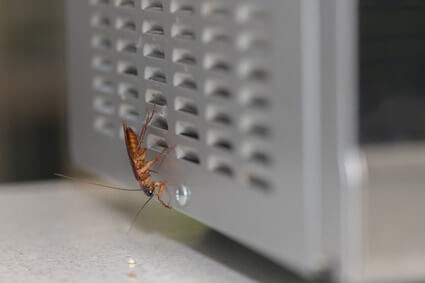
Can Cockroaches Damage A Microwave?
According to the World Health Organization, cockroaches produce secretions from their mouth and body glands.
Not only do they transmit protozoal, bacterial, and viral diseases, as explained by Salivary Gland of the Cockroach, but they corrode the microwave’s wiring and electrical parts, especially in cases where cockroaches have been inside the microwave for a long time.
Similarly, the build-up of feces, eggs, and dead cockroaches stops the microwave from functioning properly.
Worryingly, cockroaches are also responsible for electrical fires. Cockroaches eat anything, and in the absence of proper food, they’ll gnaw on wires, damaging them. It only takes one spark from a damaged wire to cause a fire, particularly if flammable substances are nearby.
So, if you notice a cockroach in your microwave, don’t leave it alone. Instead, check all areas of your appliance to determine how many cockroaches you’re dealing with and find a way to treat the problem.
Do Cockroaches Explode in The Microwave?
It’s unlikely that cockroaches will explode in a microwave. As mentioned, neither the microwave’s heat nor radiation levels are sufficient to kill a cockroach.
However, cockroaches could explode in a microwave after eating a poison solution made from sodium bicarbonate (baking powder.)
How To Get Rid Of Cockroaches in The Microwave
As soon as you notice cockroaches in your microwave, you should take steps to get rid of them. However, you must be careful because using the wrong methods could ruin your microwave or start a fire. As a result, use these microwave-safe cockroach removal solutions:
Deep Clean
If you don’t want to use the microwave while cockroaches reside inside it, deep clean it to remove all grease and spills cockroaches are attracted to. This will force them to look elsewhere for food.
Microwaves are easy to clean using standard household cleaning items. Using lemon-scented cleaning materials is even better, as cockroaches hate the smell of it.
Importantly, avoid bleach as it can damage the plastic interior and cause the appliance to work less effectively. To clean the inside:
- Combine a cup of water with lemon slices and white vinegar
- Place the bowl inside the microwave and turn it on for several minutes on the highest power setting. You want the mixture to boil and the appliance to steam up
- Leave it to cool for 5 minutes, remove the bowl, and wipe the inside with a cloth
To clean the glass tray:
- Remove the microwave tray and put it into a washing up bowl of hot water and dish cleaner
- Leave it to soak for an hour
- Scrub any remaining grease and dirt and rinse
- Spray it with a grease-cutting spray and wipe it off
- Put it back into the microwave once you’ve given the entire appliance a clean
To clean the door:
- Create a solution of water and baking soda
- Clean the entire door, including the sides, edges, and seals
- For the glass window, make a 50/50 mixture of water and white vinegar. Using a clean sponge, clean, then rinse
- Afterward, spray the entire door with a grease-cutting cleaner.
Once the microwave is free from food spills that attract cockroaches, wipe it down each time you use it to keep it clean and debris-free.
Dust Traps
Once the microwave has been stripped of its food gunk and debris, cockroaches that may be living inside or migrating back to the microwave will need to come out for food. As a result, diatomaceous earth traps work well to poison cockroaches that walk over them.
While you can apply dust traps directly to the cockroach, they work best when applied to the surrounding area. You won’t want to use the dust inside the microwave, so move the appliance to a safer, more isolated space and surround it with the dust. Be sure to place some in front of the microwave’s power outlet.
When cockroaches come out to find food, they’ll crawl over it and get poisoned. This works well for larger colonies, as once the cockroach dies, they’ll feast on the dead body. In turn, they’ll also consume the poison, eventually dying as a result.
Bait Traps
Bait traps are placed around the microwave and near spots where cockroaches emerge from. The smell of food will attract cockroaches, at which point they’ll become trapped.
You can then discard the trap and replace it. Once you stop finding cockroaches, your microwave is likely to be a cockroach-free zone. Obviously, this won’t remove any cockroach eggs hidden away, but it will remove any immediate problems.
Pest Control
While there are many DIY removal methods, you may need an expert if you have a large infestation. While you could try dismantling the microwave and removing the cockroaches by hand, you’re likely to break your appliance. Also, unless you clear cockroaches from your entire home, they’re virtually certain to return to the appliance.
How To Remove Cockroaches from Microwave Door
If you have a cockroach stuck in the microwave screen, you’ll need to take the door apart to remove it. Many modern-day door panels are held together with clips and hooks that are relatively easy to detach.
However, before you attempt this yourself, read your microwave’s manual or call the company you bought the appliance from to talk you through the process.
Once you’ve opened the door, remove the cockroach by hand and dispose of it. Then, clean the glass. A solution of water and white vinegar will remove grease and oil, discouraging other cockroaches from getting inside.
How To Get Roaches Out of Microwave Clock
While it’s unusual for cockroaches to get inside the microwave clock, you must remove it before using the microwave. To do so:
- Unplug the microwave or shut off the circuit breaker
- Locate the screws, referencing your microwave’s manual, and unscrew them
- Slide off the cabinet or remove the outer cover to access the area behind the screen
- Using a small nozzle or hose, vacuum the area to remove all cockroaches and eggs
- Wipe the area down and screw the clock back on
Can I Spray Raid in A Microwave?
Raid spray is a thick, waxy spray insecticide that turns into aerosol once triggered.
While it kills flies, wasps, cockroaches, and other insects, Raid shouldn’t be used on any electronic device, including microwaves and other kitchen appliances. That’s because it’ll cause:
- Short circuiting. Spraying your appliance with Raid is not that much different from spraying it with water.
- Corrosion. Causes long-term deterioration. You may not notice it straight away, but the corrosive effects will present themselves, causing the microwave to stop working.
- Stop the glass plate from turning. The waxiness builds up
While Raid may kill cockroaches, it’ll also stop your microwave from working.
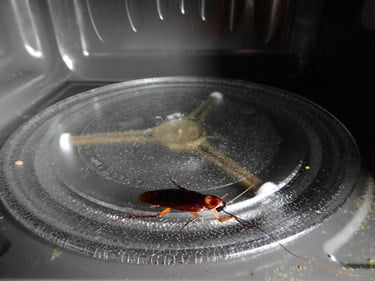
Can You Bug Bomb A Microwave?
Also known as defoggers or total release foggers, bug bombs are pesticides that release aerosol chemicals. This fumigates the area, killing any cockroaches.
Bug bombs are used in large areas against colonies of cockroaches and other pests. They do kill some cockroaches, but not the ones that are hidden away.
Also, a study by scientists at Envista Forensics found that bug bombs contain traces of water. Following a fogging application, water droplets settle on electronics, leading to:
- Corrosion of unprotected circuit boards
- Deterioration
- Electronic failure
Bug bombs contain:
- Chlorine dioxide
- Methyl bromide
- Ethylene bromide
These chemicals contribute to a microwave’s electronic component failure. They’re also flammable, so they could cause a fire when the appliance is turned on and used.
Similarly, bug bombs may cause cockroaches to retreat further into the microwave, making them even harder to remove.
How To Keep Cockroaches Away from Microwave Ovens
Now that you’ve gotten rid of cockroaches from your microwave, you must use preventative measures to stop them from returning to your appliance. Here’s how:
- Clean the microwave after every use with a damp cloth, being sure to wipe away all food spills and grease
- Keep the microwave door closed at all times
- Don’t leave uneaten food inside the microwave. Instead, place it in the bin or move it to the fridge
- Wipe away all crumbs, remembering to clean underneath the glass tray
- Use bay leaves, peppermint oil, or lemon slices in and around the microwave. Cockroaches hate the smell, so they’ll choose to stay away
Once you’ve dealt with the pests, the microwave is salvageable with a deep clean. However, the longer you allow the cockroaches to remain in the microwave, the more damage they’ll cause. The only long-term solution is to get rid of the infestation completely.
